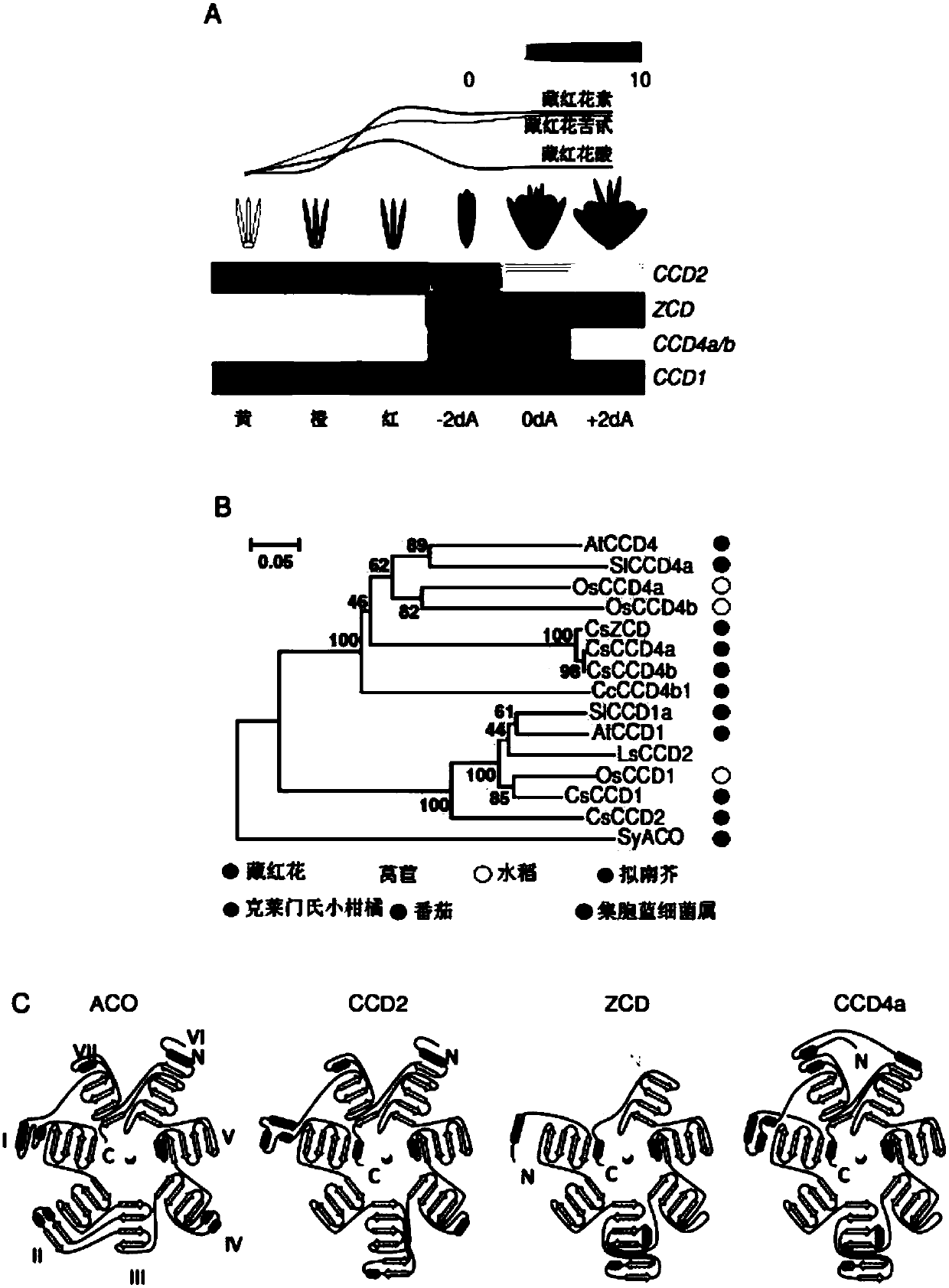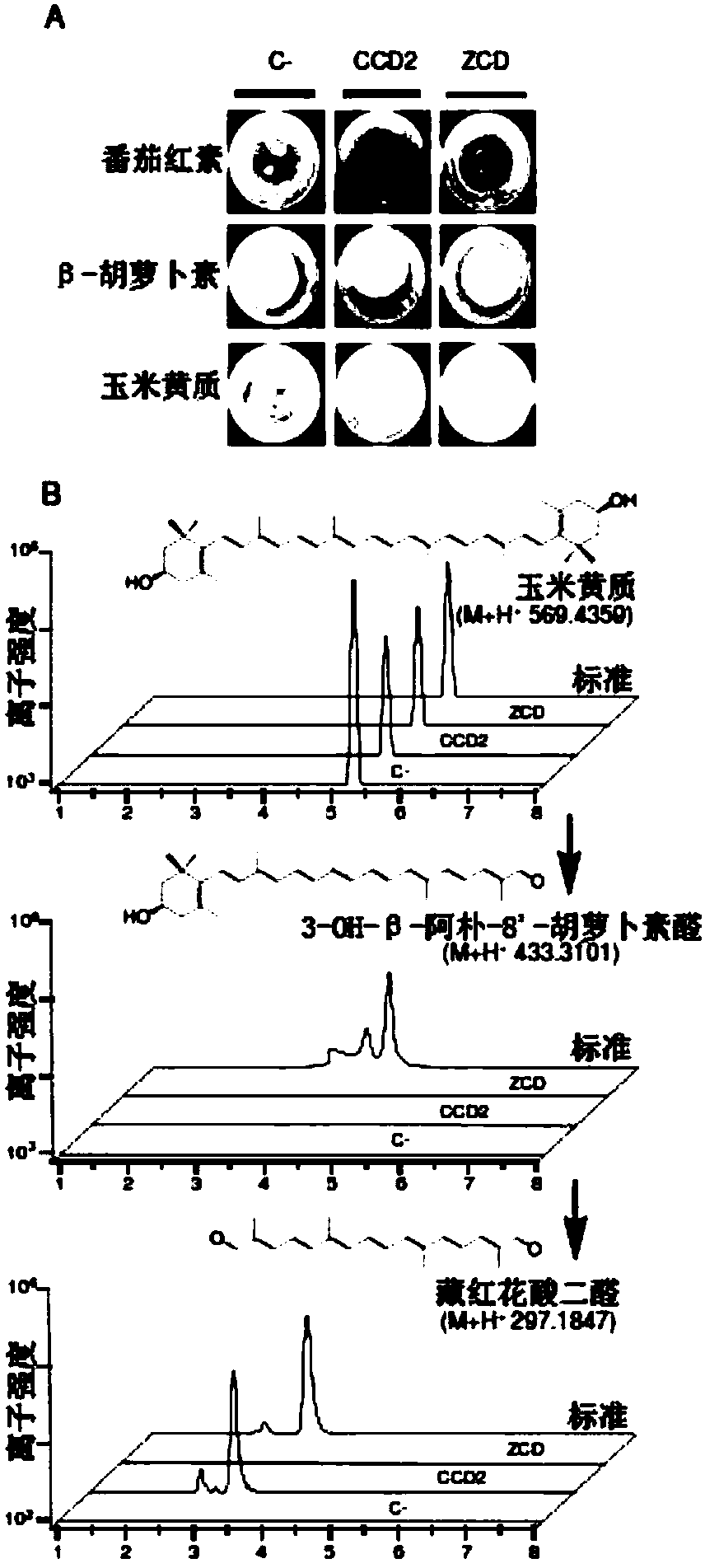A carotenoid dioxygenase and methods for the biotechnological production in microorganisms and plants of compounds derived from saffron
A technology of carotene and dioxygenase, applied in botany equipment and methods, biochemical equipment and methods, oxidoreductase, etc., can solve the problems of uncertain identification and impossible apocarotenoid compounds
- Summary
- Abstract
- Description
- Claims
- Application Information
AI Technical Summary
Problems solved by technology
Method used
Image
Examples
example 1
[0014] Example 1. Identification of the gene CCD2 expressed in the stigma of saffron: Transcripts CCD4 and ZCD are expressed during anthesis when the biosynthesis of crocetin, crocetin and crocin is substantially complete. Only CCD2 is expressed at early stages of development, where it actively synthesizes apocarotenoids ( figure 2 A) (19). Saffron's CCD2 protein is a new CCD s A member of the subfamily that is similar to, but distinct from, CCD1 ( figure 2 B). CCD2 has all seven blades retained in all CCDs forming a β-propeller structure, whereas ZCD lacks blade VII ( figure 2 C).
example 2
[0015] Example 2. Demonstration that the gene CCD2 expressed in the bacterium E. coli genetically modified to accumulate zeaxanthin converts zeaxanthin to the crocetin dialdehyde product while the gene ZCD does not have this property.
[0016] The coding sequences of genes CCD2 and ZCD were cloned into the vector pThio-DAN1, and then inducible expression in Escherichia coli was induced with arabinose. The recombinant protein was expressed in three E. coli strains accumulating lycopene, β-carotene and zeaxanthin ( image 3 A)(13)(14). At the same time, no fading and cleavage products were observed in E. coli strains accumulating lycopene and β-carotene after expression of CCD2 or ZCD ( image 3 A), but expression of CCD2 in strains of E. coli strains accumulating zeaxanthin resulted in a marked depigmentation of the bacterial cells ( image 3 A). HPLC analysis coupled with high resolution mass spectrometry (LC-HRMS) showed a peak corresponding to the m / z ratio of 297.1847 fo...
example 3
[0017]Example 3. Demonstration that the gene CCD2 expressed in maize endosperm and / or Arabidopsis thaliana cells converts zeaxanthin to crocetin product. The sequences encoding CCD2 and ZCD were cloned into the binary vector pBI121 under the control of the known promoter 35S. The resulting vector was used to transform maize endosperm and Arabidopsis cells containing zeaxanthin. Endosperms transformed with CCD2 showed discoloration, a sign of carotenoid cleavage activity, compared to endosperms transformed with vectors containing ZCD or β-glucuronidase components. LC-HRMS analysis of plant cells expressing CCD2 did not confirm the presence of 3-OH-β-apo-8'-carotene aldehyde or crocetin dialdehyde, but a corresponding m / z of crocetin equal to 329.1747 appeared A new peak than that demonstrated the same chromatographic mobility as the standard for this substrate. This transformation is due to the conversion of saffron dialdehyde to crocetin in maize endosperm (Table 1) and Arab...
PUM
 Login to View More
Login to View More Abstract
Description
Claims
Application Information
 Login to View More
Login to View More - R&D
- Intellectual Property
- Life Sciences
- Materials
- Tech Scout
- Unparalleled Data Quality
- Higher Quality Content
- 60% Fewer Hallucinations
Browse by: Latest US Patents, China's latest patents, Technical Efficacy Thesaurus, Application Domain, Technology Topic, Popular Technical Reports.
© 2025 PatSnap. All rights reserved.Legal|Privacy policy|Modern Slavery Act Transparency Statement|Sitemap|About US| Contact US: help@patsnap.com



